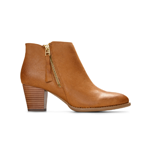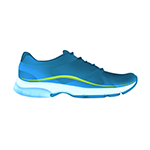
The Ultimate Guide to Footwear for Calluses
 Picture this: You haven’t sat down all day. Maybe you’ve been working overtime at a
retail job or just completed an epic hike. Finally, you return home, plop down, and kick off your shoes. As
you do, you notice some rough, raised bumps on the soles of your feet: calluses.
Picture this: You haven’t sat down all day. Maybe you’ve been working overtime at a
retail job or just completed an epic hike. Finally, you return home, plop down, and kick off your shoes. As
you do, you notice some rough, raised bumps on the soles of your feet: calluses.
If you spend extended time on your feet, calluses can pose a constant struggle.
Calluses form when ill-fitting, poorly-designed shoes create friction against your skin. They cause persistent discomfort, and if the irritation continues they can thicken and become tough to eliminate. Fortunately, smart shoe choices will quickly remedy these rough patches and help you prevent foot calluses in the future.
Read on to discover the ultimate guide to choosing footwear for calluses.
What are Calluses?
When your skin battles persistent friction, it shields itself by building up extra layers of skin at the pressure point. This new defensive layer creates a tough exterior shell. Areas that make frequent contact with the world are especially prone to callusing, such as your:
- Palms
- Heels
- Soles of your feet
While calluses do protect your skin from immediate damage, if the aggravation continues, they can grow painful and inflamed. If your job or lifestyle involves lots of standing and walking, calluses may begin to rub you the wrong way and cause daily foot pain.
The Difference Between Calluses and Corns
Before moving on, it’s important to clarify one thing: it’s common to hear the words “corns” and “calluses” used interchangeably. Both refer to hardened patches of skin, but calluses (on the feet) form on weight-bearing areas, like the soles, while corns pop up on non-pressurized points, such as the tops of the toes.
This article focuses on the impacts of calluses, but much of this information also applies to keeping your feet corn-proof or developing any similar type of foot problem.
The Root Cause of Calluses
Calluses stem from one main culprit: friction. You’ll find them standing on your feet all day when your shoes rub your skin the wrong way.
Shoes that fit poorly produce calluses in several ways. They can:
- Put your feet under pressure – When footwear is too tight, it triggers friction by squeezing your skin excessively. You should have enough room in your shoe so that your foot remains comfortable stride after stride.
- Slide around – Choosing loose shoes won’t solve the problem either. Oversized footwear will leave your feet swimming and scraping against the shoe walls.
- Cramp your toes – Some shoes come with tight toe boxes. While these may look fashionable, they don’t give your toes room to breathe.
- Apply uneven tension – Specialty footwear, like high heels, focus all their support on one area. This leads to concentrated friction and makes your skin get defensive.
An active lifestyle may also increase the risk of developing foot calluses. However, even desk jobs can rough up your soles without the proper footwear.
How The Right Footwear Can KO Calluses
Here’s the good news: Even if you’re on your feet from sunup to sundown, calluses won’t break your stride—if you’re wearing the right shoe.
Investing in supportive, well-fitting footwear can keep friction at bay and leave your feet feeling smooth when it’s time to kick them up.
Key Features of Callus-Proof Shoes
Anti-friction shoe designs play a critical role in warding off rough skin or any other similar foot problem.
The best shoes for calluses feature:
- Wide toe boxes – No need to keep your toes scrunched up and sweaty. Quality footwear gives your toes ample room to move without drifting around.
- Pliable material – You want your shoes to have some give to them. Tough, unyielding footwear fabric invites chafing.
- Seamless lining – An uneven interior can wreak havoc on your skin as you move. Choose shoes with smooth and even interiors.
- Cushy insoles – Besides boosting your shoes’ comfort levels, soft insoles take the pressure off your heel and toes.
- Breathability – Sweat softens the skin and makes it more susceptible to calluses. If you want to manage sweaty feet in shoes, go for breathable footwear so your feet stay cool and dry even in hot climates.
- Firm support – A strong foundation will keep your feet from slipping around and scraping against your shoe interior.
When shopping for fresh footwear, schedule your store visits for later in the day, as feet undergo a bit of natural swelling throughout from day to night A pair of sneakers might feel comfortable in the store, but once you’ve worn them for ten hours or more, you may discover you don’t gel as well as you initially thought.
Recommendations For Callus-Proof Shoes
What are the best shoes for calluses? It often depends on your environment. You likely cycle through a few different settings throughout the day, and avoiding calluses means having strong footwear options for any locale.
If your job has you on your feet all day, a solid pair of walking sneakers, like the Walk Max Lace Up Sneaker, is an excellent solution. These ultra-supportive sneakers come with superior cushioning and a bouncy midsole to put a spring in your step without sliding around.
Sometimes, you need to spend the day mixing and mingling in high-end settings with few sit-down breaks. For these occasions, the Uptown Loafer offers an elegant style that won’t stir up a foot callus storm as the day rolls on.
Finally, you’ll want to pick up some lounge-worthy footwear for when the day comes to a close. Take a load off in Vionic’s Rejuvenate Recovery Sandal, or the Activate Recovery Sandal. Designed to break the mold, the Cove RX is engineered with Vionic’s advanced recovery system (VRX), featuring a massaging footbed and dual-density cushioning for ultimate comfort. These sandals, with their soft, textured soles couldn’t cause a callus if they tried, and their dual-density cushioning will make you feel like you’re walking on clouds. When it comes to prioritizing your foot health, proper footwear is what’s going to help prevent callus formation and keep your feet protected all day long.
Foot Care Tips
Beyond choosing a dialed-in pair of shoes, you should also form the habit of giving your feet some TLC. After all, they carry you around all day with no complaints—don’t they deserve a little spa day now and then?
To help your feet unwind from a grueling day and to get them ready to roll out in the morning, try the following foot care tips:
- Moisturize – Inevitably, the skin on your feet will get roughed up a bit during the day. Applying a quality moisturizer softens the epidermis and keeps rough patches from hardening into troublesome calluses.
- Exfoliate – This is the process of scraping away dead skin with a specialized tool or cleanser. For feet, a pumice stone can effortlessly sand off worn-out cells and welcome new ones.
- Wear socks – Add an extra layer of protection by wearing high-quality cushioned socks. Bonus points if they have extra support in the heel region, as this is a callus hot spot. Make sure they fit snugly and don’t bunch or slide around.
- Protect with moleskin – If you have an angry foot callus forming but need to get back on your feet, pick up some moleskin (it’s silky soft) from your local pharmacy, cut it into a pair of crescent-shaped pieces, and place them around your callus.
There’s also nothing wrong with a good old-fashioned soak in warm, soapy water. Immerse your feet for about 20 minutes, then gently rub your calluses. This will remove the top layers of hardened skin. When you’re done, slip into a pair of ultra-soft, comfy sandals like the Relax II Slippers or Gemma II Mule Slippers.
How Often to Replace Shoes to Maintain Healthy Feet
When you find that perfect shoe—the kind that fits like a glove and puts some pep in your step as soon as you lace them up—it’s easy to fall head over heels.
Unfortunately, the sweetest footwear romances must come to an end. Worn-out shoes, even if they were love at first sight, can contribute to calluses and foot fatigue.
So, how long do walking shoes really last?
If we’re talking about active shoes (ones that you step into when it’s time to stroll, run, or hike), then the experts recommend swapping them out after about 6 months or 500 miles (whichever milestone you hit first).
Indoor shoes’ retirement age depends more on feel than any specific timeline. Well-crafted shoes last longer, and your unique gait will contribute to wear spots. To gauge when it’s time to upgrade, ask yourself the following:
- How do my feet feel? – Do your soles feel sore at the end of the day? Are you starting to notice foot calluses where there were none before? Tired, beat-up feet are the biggest red flag that your footwear’s life is winding down.
- Are my shoes looking burned out? – Take a look at your shoes’ soles. Are they worn down more on one side or the other? Is the heel curved? Misshapen shoes can contribute to uneven pressure and callus-causing friction.
As tough as it is to say goodbye to a beloved sole mate, replacing footwear regularly is a healthy habit that can keep you ahead of callus formation.
Vionic: A Haven for Healthy Feet
You shouldn’t have to spend life sitting down because of callus discomfort. Your path to an active lifestyle starts with healthy feet. The best way to ensure your feet are ready for anything? Show them some love and keep them callus-free.
At Vionic, we craft high-quality footwear with precision designs and feathery orthotic insoles that will keep your feet comfy in all kinds of environments, from the office to the hiking trail.
Say hello to a life on the go—without foot fatigue. Explore our catalog today.
Sources:
Mayo Clinic. Corns and calluses. https://www.mayoclinic.org/diseases-conditions/corns-and-calluses/symptoms-causes/syc-20355946
Old Bridge Foot Doctor. Preventing and Treating Calluses and Corns. https://oldbridgefootdr.com/blog/2021/2/23/preventing-and-treating-calluses-and-corns#:~:text=If%20you%20exercise%20outside%20by,a%20job%20for%20a%20professional.
My Foot Dr. Do you experience corns and calluses on your feet? Let’s talk about the importance of footwear. https://www.myfootdr.com.au/2023/04/do-you-experience-corns-and-calluses-on-your-feet-lets-talk-about-the-importance-of-footwear/#:~:text=Wearing%20shoes%20that%20don’t,to%20the%20development%20of%20corns.
Florida Foot Specialists. What Are the Best Shoes for Corns and Calluses? https://floridafootspecialists.com/what-are-the-best-shoes-for-corns-and-calluses/
Healthline. What Does It Mean to Exfoliate? Why You Should and How to Start. https://www.healthline.com/health/beauty-skin-care/meaning-of-exfoliating
Foot Injury Clinic. Four Steps to Prevent Calluses. https://www.footinjuryclinic.com/blog/four-steps-to-prevent-calluses/
American Academy of Dermatology Association. How To Treat Corns and Calluses. https://www.aad.org/public/everyday-care/injured-skin/burns/treat-corns-calluses#:~:text=To%20protect%20calluses%20from%20further,pads%20%E2%80%93%20also%20available%20at%20drugstores.
Old Bridge Foot Doctor. Preventing and Treating Calluses and Corns. https://oldbridgefootdr.com/blog/2021/2/23/preventing-and-treating-calluses-and-corns#:~:text=If%20you%20exercise%20outside%20by,a%20job%20for%20a%20professional.
Solon Foot and Ankle. How Often Should You Replace Your Shoes? https://solonfootandankle.com/2022/11/21/how-often-should-you-replace-your-shoes/










